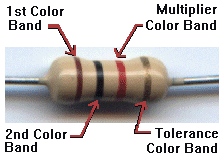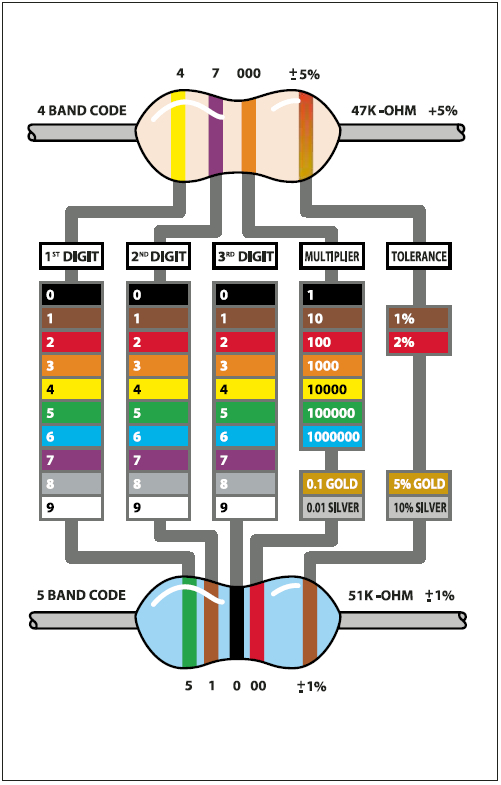Function
To limit the current and divide the voltageOperating Values
There are two ratings: Resistance value rated in ohmsΩ and a power rating in watts (W).Resistors are color coded for easy reading:
RESISTOR COLOR
CODE CALCULATOR
Common Resistor
To determine the value of a given resistor look for the gold or silver tolorance band and rotate the resistor as in the photo above.(Tolerance band to the right). Look at the 1st color band and determine its color. This maybe difficult on small or oddly colored resistors. Now look at the chart and match the "1st & 2nd color band" color to the "Digit it represents". Write this number down.
Now look at the 2nd color band and match that color to the same chart. Write this number next to the 1st Digit.
The Last color band is the number you will multiply the result by. Match the 3rd color band with the chart under multiplier. This is the number you will mulitple the other 2 numbers by. Write it next to the other 2 numbers with a multiplication sign before it. Example : 2 2 x 1,000.
To pull it all together now, simply multiply the first 2 numbers (1st number in the tens column and 2nd in the ones column) by the Multiplier.
Example:

- First color is red which is 2
- Second color is black which is 0
- third color is yellow which is 10,000
- Torerance is silver which is 10%
Therefore the equation is:
2 0 x 10,000 = 200,000 Ohms
| 1st. & 2nd Color Band | Digit it Represents | -----Multiplier----- |
| 0 | 1 | |
| 1 | X10 | |
| 2 | X100 | |
| 3 | X1,000 or 1K | |
| 4 | X10,000 or 10K | |
| 5 | X100,000 or 100K | |
| 6 | X1,000,000 or 1M | |
| 7 | Silver is divide by 100 | |
| 8 | Gold is divide by 10 | |
| 9 |
|
Tolerance Explanation
Resistors are never the exact value that the color codes indicate.Therefore manufacturers place a tolerance color band on the resistor to tell you just how accurate this resistor is made. It is simply a measurment of the imperfections. Gold means the resistor is within 5% of being dead-on accurate. Silver being within 10% and no color band being within 20%. To determine the exact range that the resistor may be, take the value of the resistor and mutiply it by 5,10, 0r 20%. That is the number that the resistor may go either way.
Example: A 1,000 Ohm resistor with a gold band maybe any value between 950 to 1050 Ohms.
Example: A 22,000 Ohm resistor with a silver band maybe any value between 19,800 and 24,200 Ohms.
FAQ
Just a few common questions to help you out.
1) Which side of the resistor do I read from?
The Gold or Silver band is always set to the right, then you read from left to right. Sometimes there will be no tolerance band -- Simply find the side that has a band closest to a lead and make that the first band.
2) Sometimes the colors are hard to make out. How do I make certain what the value of the resistor really is?
Occasionally the colors are jumbled or burnt off. The only way to read it then is with a multimeter across the leads
3) How do I remember this sequence of colors?

Remember the color codes with this sentence: Big Brown Rabbits Often Yield Great Big Vocal Groans When Gingerly Slapped.
GRAPHICAL RESISTANCE CALCULATOR in JAVASCRIPT
Version 2.0
by Danny Goodman (dannyg@dannyg.com)
Analyzed and described at length in
JavaScript Bible"
(IDG Books ISBN 0-7645-3022-4)
This program is Copyright 1996 by Danny Goodman.
